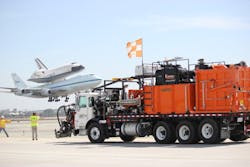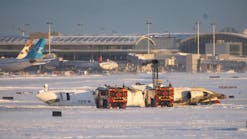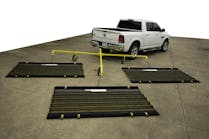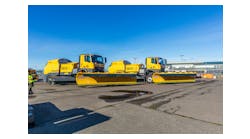It’s time for the rubber to meet the road – or in this case – for the rubber to leave the runway. A rubbery runway can lead to reduced friction, a bouncy landing or worse for a plane and pilot if left unchecked. Luckily, there’s a star on the horizon ready to remove that rubber with up to 40,000 psi blasts of water – NLB Corporation’s StarJet.
“The equipment affords you the ability to remove rubber and pavement markings without damaging the surface, or scarring the surface. The water will penetrate into the pores of the surface so that you can remove the marking 100 percent,” described Troy Aldea, sales engineer at NLB Corporation. “So, there’s no grinding involved. There’s no chemicals involved. Sometimes, airports will do rubber removal and they’ll use a chemical to remove the rubber. With high pressure water, it can be done without chemicals.”
The first StarJet was launched in 1995 when NLB realized there was a market for removing markings without damaging the surfaces those markings were on.
“NLB was using high pressure water from removing coatings and steel office buildings and shop floors. It was just a natural progression into the highway industry,” added Aldea.
It was then another “makes sense” transition from highway to runway and 24 years later in 2019, NLB offers four different models of StarJet – the SRV-1, the SRV-4, SRV-4S, and SRV-6.
For airports, Aldea said the best options are the SRV-4S and SRV-6 because “the removal head traverses from side to side as the truck moves forward. So, you’re able to get a eight foot wide cleaning path.”
Some of the key features of the StarJet include NLB’s high pressure pumps which, Aldea said, has a life of between between 1,000 and 1,500 hours and a maximum output of up to 40,000 psi. The StarJet has an onboard supply of freshwater and vacuum recovery. On the SRV-4s and SRV-6, there are dual wide cleaning heads allowing from between a 10 inch wide and 27 inch wide cleaning pattern. There’s also onboard debris storage and waster water, and the ability to separate water from debris for easy dumping.
A new feature introduced this year is the ability to integrate Wi-Fi with the StarJets, allowing for the wireless monitoring of the StarJet’s programs and systems.
Training for an airport technician comes in two phases Aldea described.
“During the first round, the customers send their people to NLB and they go through a full three or four days of training at our facility. We talk about safety. Our safety portion of the training is done in conjunction with WJTA guidelines, then we cover operations and maintenance. And there’s hands on training out in the shop where they actually get to operate a truck in the yard there and do a little bit of removal as part of the training program. They’re also out in the shop taking apart things, putting them back together, and then actually testing the truck after they’ve done that, so they make sure they’ve done it the right way. And then the second round of training, NLB sends a technician out to the customer’s location and pretty much operations and maintenance training is done at the customer’s location, and that’s typically a three day process,” he said.
To help keep the StarJet in working order, Aldea said the primary maintenance an operator needs to worry about is simply greasing the system, replacing nozzles, “nozzle covers” and high pressure seals.
“NLB offers a maintenance kit program. What that entails is a customer purchasing a kit that contains modular components that are inside of an NLB pump. They open up their pump and they swap out the components in the pump for what’s in the kit, they send the used components in the kit back to NLB and we totally go through all of those components and refurbish them. They pay $500 for the kit, but it won’t cost them anything to have refurbishment of the items in the kit. It’s kind of an insurance policy that allows them to have fresh components in the pump and they don’t have to worry about a pump going down on a job,” Aldea said.
And Aldea said the feedback from customers utilizing the StarJet has been useful and NLB incorporates that feedback into future updates for the machine.
“We get feedback from customers that they like the low cost of operation from our truck. They like the production that our trucks give because one of the things that we do a little bit differently than the other guys out there, is we have a dedicated pump engine that drives only the high pressure pump. And the other guys out there, they will drive everything off of the truck engine and so they’re sharing that horsepower amongst the other systems. With the NLB, we’ve got a dedicated pump engine that is just for high pressure water that that works to greatly extend the life of the truck engine, and more consistent water pressure flow when demands are being put on the truck like when going up a hill.





